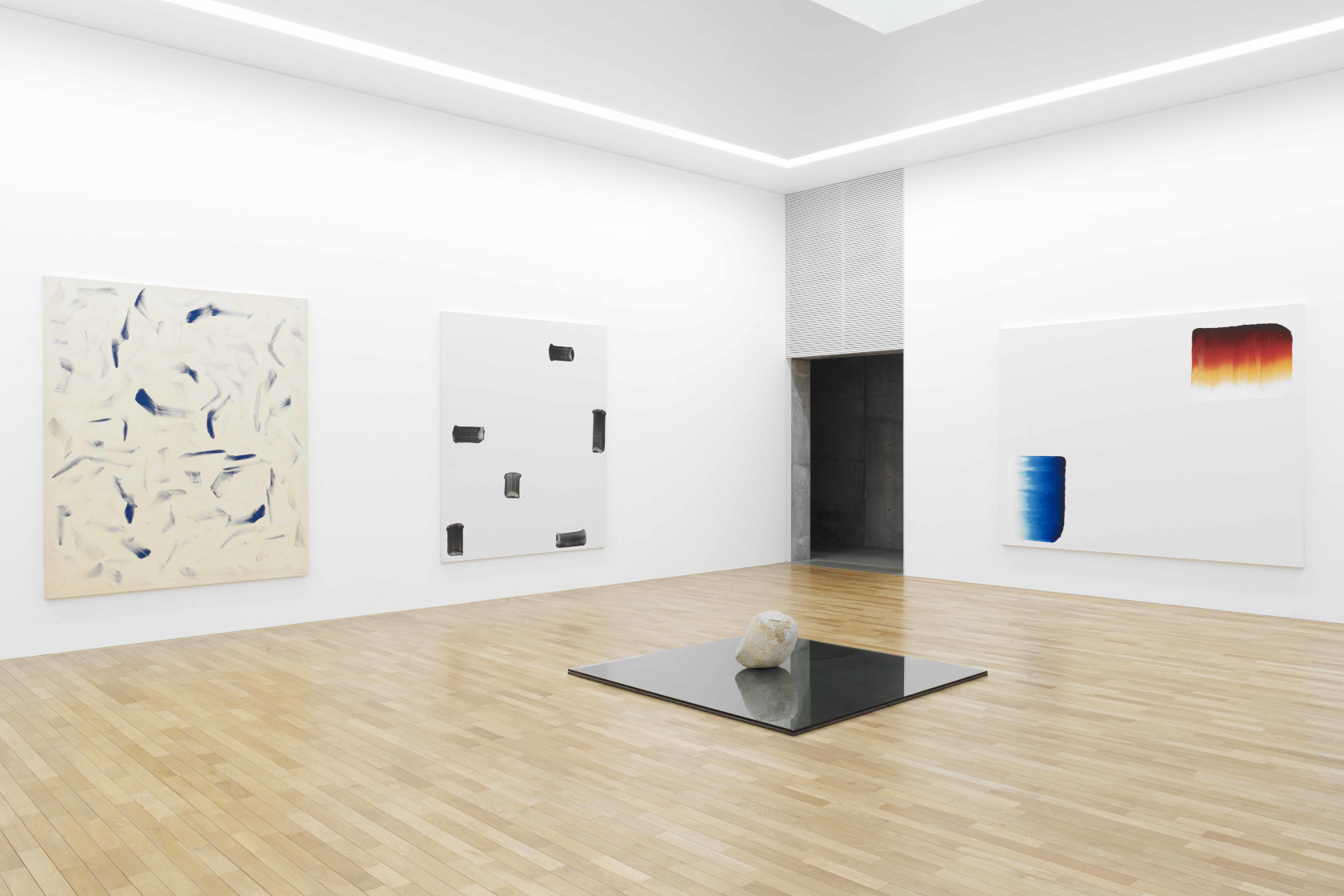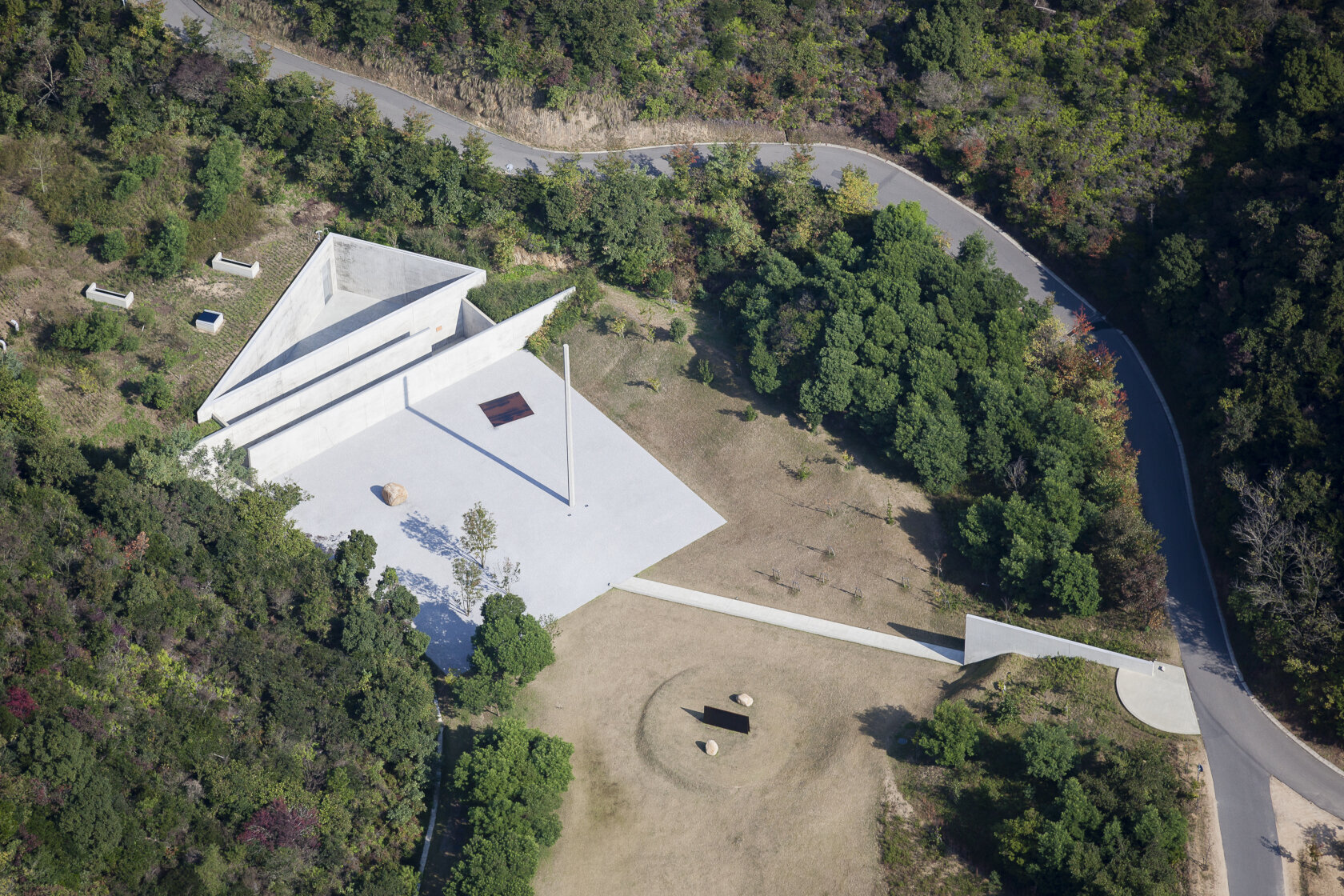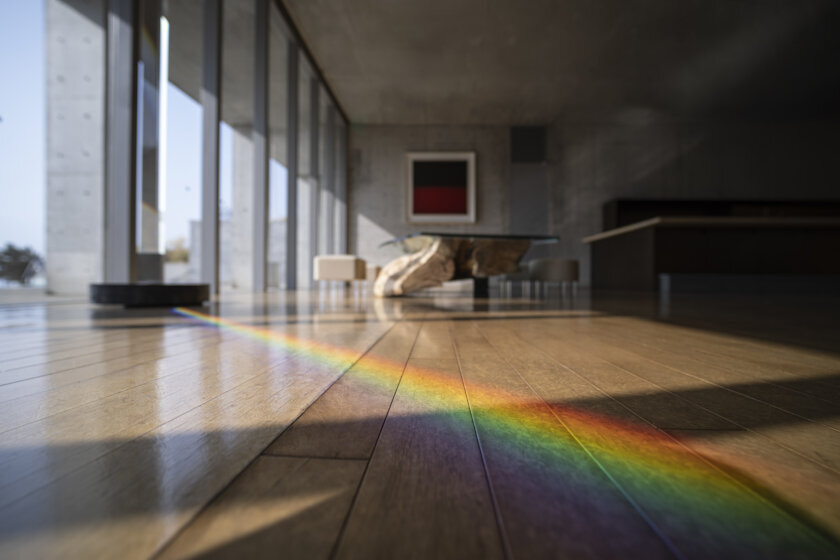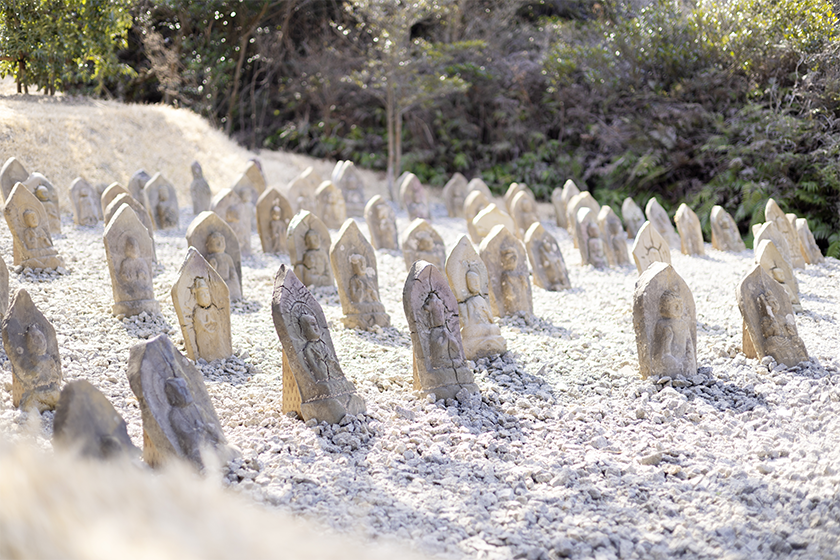Yayoi Kusama: "Art is an Endless Struggle, Art is Love, Art is Life" (#1)
Pumpkin, a Solemn Existence on the Pier

In August 2021, Pumpkin, the yellow pumpkin-shaped sculpture by Yayoi Kusama that is recognized not only as the symbol of Benesse Art Site Naoshima but also as an icon of the entire island, caused a stir when it was washed away by the waves of a hurricane. Video footage of the scene was circulated all over the world.
This sculpture has been evacuated every time a hurricane is forecasted in the region. Although Naoshima was not expected to be within the path of the storm that day, a gusty wind pushed the work into the sea in the flash of a moment.
After Pumpkin was immediately retrieved, discussions were held with the artist and all people concerned, and it was decided upon to adopt new measures for the sculpture.*1 While being awestruck by the growing fury of the weather and the seriousness of climate change, and realizing how social media could change a moment of daily life into a major spectacle, we were amazed by the number of comments sent to express worries about the sculpture. It seemed like the opportune time for us to reflect upon Yayoi Kusama as a unique artist and the meaning and message of Pumpkin exhibited on Naoshima.
This particular work Pumpkin was created for the 1994 exhibition "Open Air '94 'Out of Bounds,'" in which works of art were exhibited outdoors in the natural environment around Benesse House Museum, a facility unifying a hotel and an art museum that opened in 1992 and was designed by Tadao Ando.*2 As Kusama had been creating outdoor sculptures since 1994, this particular pumpkin was one of the first works the artist intended to exhibit outdoors from the initial onset. The large-scale work measuring 2-meters high and 2.5-meters wide was the biggest pumpkin sculpture that had been created to date.
While originally intended to be shown only during the exhibition period, it was decided that this yellow pumpkin and four other works related to the seascape were to remain as permanent exhibitions, which led to the formation of Benesse Art Site Naoshima's guiding policy of the "Symbiosis of Nature, Architecture and Art."
While Naoshima is now popular as an "island of art," the activities of Benesse Art Site Naoshima were not known even to local residents because they had just begun when the yellow pumpkin was installed in the first half of the 1990s. Visitors to the island were so few back then that sometimes they had the experience of having the hotel and gallery spaces all to themselves (which in a sense must have been such a privileged experience.) Benesse Art Site Naoshima was a place known only to a limited number of people, and I remember there being only one restaurant on the island, an udon noodle shop, back in those days.
Kusama was a somewhat marginal artist until the 1980s but gradually came to be reevaluated since around 1990 which led to her participation in the 1993 Venice Biennale as the representative artist of Japan.
As if following Kusama's accomplishments, Benesse Art Site Naoshima expanded its activities to the Venice Biennale from 1995, commemorating the change of its corporate name from Fukutake Publishing to Benesse Corporation. It began an initiative to present an exhibition in the Biennale and founded the Benesse Prize, which marked its debut and fostered its worldwide network and subsequent recognition in the international art scene.
In short, the activities of Benesse Art Site Naoshima and the worldwide reputation of Kusama developed in parallel from around that time.
The yellow sculpture Pumpkin, standing all alone on the border of the land and sea on the tip of the pier protruding out to the water, reflects the concept of the "Out of Bounds" exhibition representing encounters with diverse values crossing over boundaries between various established ideas and systems. At the same time, it visualizes the essence of contemporary art pushing various limits as well as somehow evoking a portrait of the artist.
Kusama has transferred her trauma into creativity and opened up a new horizon while struggling against obstacles. This work reflects her life as such and also seems to represent how Benesse Art Site Naoshima has communicated alternative values and ways of life to the rest of the world from a remote island in the far east.
*1. As of June 2022, it has not yet been decided when the sculpture will be re-installed.
*2. It was curated by Fumio Nanjo and Yuji Akimoto and participated in by 11 artists / collectives, namely, Shinro Ohtake, Kenjiro Okazaki, Kazuo Katase, Yayoi Kusama, Hotaro Koyama, Hiroshi Sugimoto, Technocrat, Yasutaka Nakanowatari, PH Studio, Takuya Matsunoki and Takashi Murakami.
A New Horizon - Challenges in New York City
Born to a wealthy family managing a seed nursery company in Matsumoto, Nagano in 1929, Yayoi Kusama liked drawing from early on. Dots covering all-over, characteristic of her mature style and derived from her childhood experiences, already appeared in the drawings she made at a very young age.
"I drew pictures not because I wanted to become an artist but because of my obstinate sickness: anxiety, obsession, and paranoia. I remember having fear of the same images rushing to me one after another. When I saw white dots swarming and multiplying all over the shadowy concrete wall on the north side of my elementary school, my soul broke away from my body. I always depicted this scene. I had to depict it to watch it sufficiently. Otherwise, I would pass out."3
Growing up in a conservative family in the pre-WWII period, Kusama was agonized by her complicated domestic circumstances. For the artist who has made paintings covered all-over in order to escape from visual and auditory hallucinations, creating works of art was probably the way for her to heal from her trauma and was equal to living.
Graduating from a women's high school, Kusama studied Nihonga at an art school in Kyoto but later returned to her home in Matsumoto. She started to exhibit her works from 1950 in Matsumoto, Tokyo, and other places. While she was struggling with trauma, her prominent talent was recognized from early on. The art critic Shuzo Takiguchi contributed a text for a solo exhibition brochure and organized exhibitions of her work.
It was New York, however, that made Kusama's creativity fully bloom. She moved to the United States in 1957 when a solo exhibition of her work was held in Seattle. It is said that she had been considering New York as the frontline for post-war art rather than Paris from before, and that she was determined to go to New York, even writing a letter to Georgia O'Keeffe.
When American artist Robert Rauschenberg won the Golden Lion Prize at the 1964 Venice Biennale, it was evident that the center of contemporary art had shifted from Europe to the United States. In addition to her creativity, Kusama seemed to have a special ability to read the currents of the time and draw them towards her.
It was not easy for a female artist to have a solo exhibition in New York City when Kusama arrived. However, she was able to accomplish this in 1959 despite being an artist from Japan. Her painting shown in the first solo exhibition, Infinity Net, a large-format, all-over composition with a minimum depth, was favorably received in the art scene of New York, where Abstract Expressionism was declining while new trends such as Minimalism, Color Field Painting, and Pop Art were emerging, attracting attention from notable critics such as Herbert Read, as well as artists such as Donald Judd, who even purchased her work.
Besides Judd, there were quite a few cutting-edge artists active around the city in those days, such as Mark Rothko, Barnett Newman, Andy Warhol, and Claes Oldenburg. When I was curating for the 1998 Taipei Biennale and other events, I had chances to discuss with Kusama and heard several times that she had had her expressions stolen by other artists. Whether it was true or false, she was certainly there amid the severe competition of artists who would become new frontrunners of contemporary art.
In 1961, Kusama began to create a series of soft sculptures composed of numerous phallic, stuffed protrusions made of fabric covering the entire surfaces of chairs, beds, and boats. The "Accumulation" series expanded to cover the entire room and space and was infinitely reinforced by adding mirrors.
After Infinity Mirror Room - Phalli's Field, in which mirrors were used effectively, Kusama repeatedly created mirror rooms which became one of her representative series. The artist thus overcame her fear and aversion towards the phallus and sexuality by creating works filled with repeated phallic forms.
*3. Kusama's words quoted in Atsushi Tanigawa, "Zoshoku no Gemma", Bijutsu Techo, June 1993, p.67.
Back in Japan - Varying Expressions and Reevaluation
Another direction taken in the artist's work, with the expanding of images across new boundaries, was through happenings that she practiced on the street and other places starting from the 1960s. Especially between the years of 1967 and 1970, parallel to the surge of the hippy movement that advocated returning to nature and regaining humanity, as well as the Anti-Vietnam War movement and critical arguments against a Capitalist economy, Kusama held demonstrations and fashion shows in which naked models with dots painted all over their bodies and models dressed in costumes she designed herself, walked around indoor spaces and in the streets.
Kusama also made "Kusama Dresses" and original textiles that were sold in department stores and fashion stores all over the United States. She even opened her own boutique in 1969. Kusama grew increasingly active in producing work, such as making a film starring herself in 1968, but she also became the subject of a police investigation and a target of criticism from the media for her happenings.
After Joseph Cornell, Kusama's closest friend, passed away, Kusama returned to Japan in 1973 suffering from a health problem. In 1977, she checked into a hospital ward and has been living and working there ever since.
During this period, Kusama's works suggested the influence of death, and showed lyrical and introspective tendencies as often pointed out. While she could not create large-scale works due to her physical condition and other reasons, she took up new mediums such as ceramics, pastel works, collages, and silkscreens, through which she could reproduce her images, and writings such as novels exemplified by Manhattan Jisatsumisui Joshuhan [Manhattan Suicide Addict] and poetry.
While Kusama presented solo exhibitions at galleries in Japan such as Fuji Television Gallery since the early 1980s, and her writings were critically well-received, her works did not attract much attention from art museums. She was thus almost forgotten within the contemporary art scene in those days.
It was a major retrospective exhibition of Kusama's work held in 1989 at the Center for International Contemporary Art, newly founded in New York, that led to a renewed appreciation for the artist.(Continued in #2 article)
Akiko MikiBenesse Art Site Naoshima International Artistic Director / Director, Naoshima New Museum of Art (Open in Spring 2025)
Former Chief and Senior curator, Palais de Tokyo (2000-2014), Co-director, Yokohama Triennale 2017 and Artistic Director of its 2011 edition among others. She was also guest curator for many large-scaled exhibitions including the ones of Japanese artists such as Nobuyoshi Araki, Hiroshi Sugimoto, Takashi Murakami at major museums in Asia and Europe as Barbican Art Gallery, Taipei Fine Art Museum, National Museum of Contemporary Art, Seoul, Mori Art Museum, Yokohama Museum of Art, and Kyoto City KYOCERA Museum of Art.







